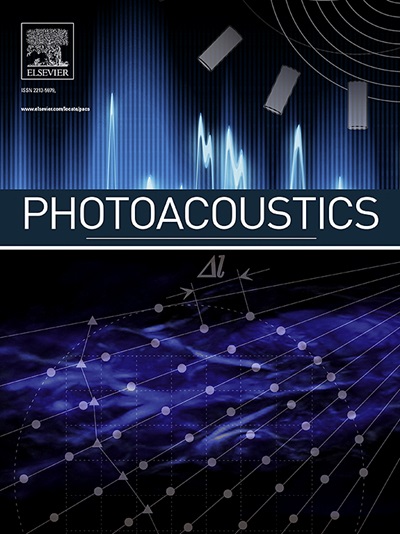High resolution photoacoustic vascular image reconstruction through the fast residual dense generative adversarial network
IF 7.1
1区 医学
Q1 ENGINEERING, BIOMEDICAL
引用次数: 0
Abstract
Photoacoustic imaging is a powerful technique that provides high-resolution, deep tissue imaging. However, the time-intensive nature of photoacoustic microscopy (PAM) poses a significant challenge, especially when high-resolution images are required for real-time applications. In this study, we proposed an optimized Fast Residual Dense Generative Adversarial Network (FRDGAN) for high-quality PAM reconstruction. Through dataset validation on mouse ear vasculature, FRDGAN demonstrated superior performance in image quality, background noise suppression, and computational efficiency across multiple down-sampling scales (×4, ×8) compared to classical methods. Furthermore, in the in vivo experiments of mouse cerebral vasculature, FRDGAN achieves the improvement of 2.24 dB and 0.0255 in peak signal-to-noise ratio and structural similarity metrics in contrast to SRGAN, respectively. Our FRDGAN method provides a promising solution for fast, high-quality PAM microvascular imaging in biomedical research.
基于快速残差密集生成对抗网络的高分辨率光声血管图像重建
光声成像是一种强大的技术,可以提供高分辨率的深层组织成像。然而,时间密集的性质光声显微镜(PAM)提出了一个重大的挑战,特别是当高分辨率的图像需要实时应用。在这项研究中,我们提出了一种优化的快速残差密集生成对抗网络(FRDGAN),用于高质量的PAM重建。通过对小鼠耳血管系统的数据集验证,与经典方法相比,FRDGAN在图像质量、背景噪声抑制和跨多个降采样尺度的计算效率方面表现出了卓越的性能(×4, ×8)。此外,在小鼠脑血管体内实验中,FRDGAN在峰值信噪比和结构相似性指标上分别比SRGAN提高了2.24 dB和0.0255。我们的FRDGAN方法为生物医学研究中快速、高质量的PAM微血管成像提供了一个有前途的解决方案。
本文章由计算机程序翻译,如有差异,请以英文原文为准。
求助全文
约1分钟内获得全文
求助全文
来源期刊

Photoacoustics
Physics and Astronomy-Atomic and Molecular Physics, and Optics
CiteScore
11.40
自引率
16.50%
发文量
96
审稿时长
53 days
期刊介绍:
The open access Photoacoustics journal (PACS) aims to publish original research and review contributions in the field of photoacoustics-optoacoustics-thermoacoustics. This field utilizes acoustical and ultrasonic phenomena excited by electromagnetic radiation for the detection, visualization, and characterization of various materials and biological tissues, including living organisms.
Recent advancements in laser technologies, ultrasound detection approaches, inverse theory, and fast reconstruction algorithms have greatly supported the rapid progress in this field. The unique contrast provided by molecular absorption in photoacoustic-optoacoustic-thermoacoustic methods has allowed for addressing unmet biological and medical needs such as pre-clinical research, clinical imaging of vasculature, tissue and disease physiology, drug efficacy, surgery guidance, and therapy monitoring.
Applications of this field encompass a wide range of medical imaging and sensing applications, including cancer, vascular diseases, brain neurophysiology, ophthalmology, and diabetes. Moreover, photoacoustics-optoacoustics-thermoacoustics is a multidisciplinary field, with contributions from chemistry and nanotechnology, where novel materials such as biodegradable nanoparticles, organic dyes, targeted agents, theranostic probes, and genetically expressed markers are being actively developed.
These advanced materials have significantly improved the signal-to-noise ratio and tissue contrast in photoacoustic methods.
 求助内容:
求助内容: 应助结果提醒方式:
应助结果提醒方式:


